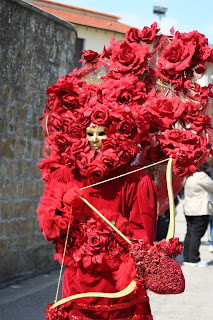Sansepolcro, September 11th 2016
 In Sansepolcro is still living the tradition of the typical medieval crossbow shooting, the apex of the spread of the crossbow has occurred between 1200 and 1400 with the use of the weapon for military purposes.
In Sansepolcro is still living the tradition of the typical medieval crossbow shooting, the apex of the spread of the crossbow has occurred between 1200 and 1400 with the use of the weapon for military purposes.Nowadays, if you talk about crossbow in San Sepolcro it refers to the competition which takes place in September, organized in honor of Sant'Egidio, documented since 1594 : the first takes place between Rioni the Monday following the first Sunday of September, the second takes place between Gubbio and Sansepolcro on the second Sunday of September. The second prize is certainly the most famous and attended by more viewers .The site chosen for the races is the Piazza Torre di Berta, center of city life at 4:15 p.m . Before the game, there is a historical parade that starts from the Piazza . The procession moves in an atmosphere full of colors, costumes, weapons, flags, resulting in the head with the standard-bearer of the banner truncated black and white of Sansepolcro, escorted by two mace-bearers and followed by the Captain of armed warriors. All the characters are wearing costumes inspired by the frescoes of Piero della Francesca, who lived in Sansepolcro and he was himself a crossbowman. Then follow notables, nobles, ladies, knights, pages, standard bearers, musicians and flag bearers . The group, which made up the procession of Gubbio is present with a similar number of participants.
The archers must hit a target and every shooter has only have one shot .The target is located at thirty meters away from the bench where they are resting on the spring and consists of a circular board of wood, from which protrudes a truncated cone , the ends of which has a diameter of thirteen centimeters. The center of the cone is marked by a dark disk of three inches in diameter and the archers try to hit precisely this point .
At the archer will win the Palio, once it was a valuable embroidered cloth for a dress, nowadays it is a work of an artist.
The city is also party a few days earlier, in fact, it begins on Wednesday, August 31st at 9:00 p.m with the prize between the districts, on Friday, September 9th at 8:00 p.m the banquet is held under the loggia of Renaissance Square of Lauds, an occasion when you can savor tastes, smells typical of a Renaissance banquet. On Saturday, September 10th from 5:00 p.m, then, there is the offer of the candle in the Cathedral: a mass well wishes for the presence of representatives of the guilds. At 9:00 p.m, the party continues with the show of the flag.
Sansepolcro, domenica 11 settembre 2016
A Sansepolcro vive ancora la tradizione tipicamente medievale del tiro della balestra "grossa"; l'apice della diffusione della balestra si è avuta fra il 1200 ed il 1400 con l'uso dell'arma a scopi militari.
Oggi giorno se si parla di balestra a Sansepolcro ci si riferisce alla competizione che ha luogo a settembre, organizzato in onore di Sant'Egidio, documentata sin dal 1594 : la prima si svolge fra Rioni il lunedì successivo alla prima domenica di settembre, la seconda si disputa fra San Sepolcro e Gubbio la seconda domenica di settembre. Il secondo palio è sicuramente quello più famoso ed a cui partecipano più spettatori.
Il luogo prescelto per le gare è la Piazza Torre di Berta, centro della vita cittadina, alle ore 16.15. Prima dell'inizio del gioco, sfila il corteo storico che parte dalla Piazza. Il corteo si muove in un'atmosfera ricca di colori, costumi, armi, bandiere, portando alla testa il Vessillifero con il gonfalone troncato di bianco e nero di Sansepolcro, scortato da due mazzieri e seguito dal Capitano degli armati e otto armigeri. Tutti i figuranti indossano costumi ispirati agli affreschi del concittadino Piero della Francesca, che fu anche lui balestriere. Quindi seguono notabili, nobili, dame, cavalieri, paggi, alfieri, musici e sbandieratori. Il gruppo, che compone il corteo di Gubbio è presente con un analogo numero di partecipanti.
I balestrieri devono colpire un bersaglio ed ogni tiratore ha a disposizione un solo tiro.
Il bersaglio si trova a trentasei metri di distanza dalla panca dove sono appoggiate le balestre e consiste in una tavola circolare di legno, da cui sporge un tronco di cono, la cui estremità ha un diametro di tredici centimetri. Il centro del cono è segnato da un dischetto nero di tre centimetri di diametro ed i balestrieri cercano di colpire proprio questo punto.
Al balestriere vincente andrà il Palio, un tempo era un prezioso drappo ricamato per confezionarsi un abito, oggi giorno si tratta di un'opera di un artista.
La città è in festa anche nei giorni precedenti, infatti si comincia mercoledì 31 agosto alle ore 21.00 con il palio tra i rioni, venerdì 9 settembre alle ore 20.00 si tiene il convivio rinascimentale sotto il loggiato di Piazza delle Laudi, un'occasione in cui poter assaporare sapori, odori tipici di un banchetto rinascimentale. Sabato 10 settembre dalle ore 17.00, poi, c'è l'offerta del cero nella Cattedrale di Sansepolcro: una messa ben augurale alla presenza dei rappresentanti delle corporazioni. Alle 21.00 la festa continua con lo spettacolo degli sbandieratori. Segui Tuscany in a nutshell su Google+






















